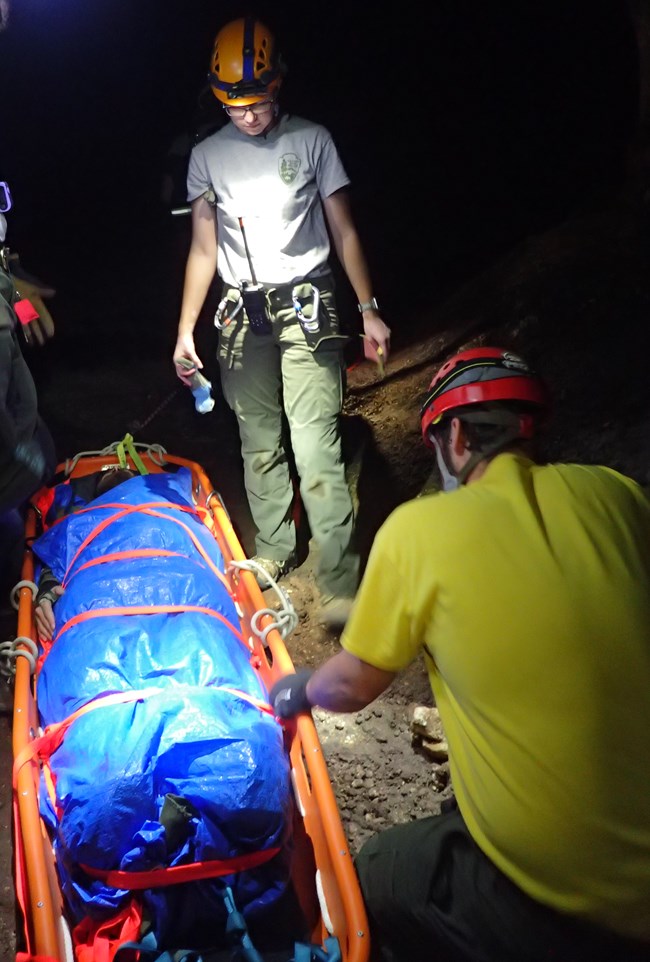Part of a series of articles titled Inside Earth – NPS Cave & Karst News – Fall 2020.
Next: Covid-19 and NPS Caves
Article

NPS photo by Shane Fryer.
Submitted by Joel Despain, NPS Cave and Karst Management Coordinator
for Inside Earth Newsletter, Fall 2020
It was an unusual site—resource management experts, law enforcement and interpretation rangers, and administrative staff assembled and intently listening to the plan for the day. The team was surrounded by packs, ropes, helmets and bags of gear – a veritable mountain of equipment that invoked the rugged Guadalupe Mountains that were the backdrop for the parking lot gathering. What led to nearly a quarter of the staff of Carlsbad Caverns to assemble on a warm fall day? Cave search and rescue.
Search and rescue in caves are thankfully rare. But when such operations do occur, they are generally expensive, complex, gear intensive and potentially dangerous for all involved. How to prepare for the rare, but inevitable? Practice. Many cave and karst parks practice and work to prepare for cave search and rescue (see accompanying photo from Lava Beds National Monument, California). Carlsbad helps to lead the way with irregular but frequent cave search and rescue practices and the participation of staff from many park divisions. In 2018, the park hosted a week-long cave search and rescue training coordinated by the National Cave Rescue Commission of the National Speleological Society. It is not surprising that cave search and rescue is an important consideration at Carlsbad Caverns. The park contains two of the longest caves in the United States and the second deepest. Arguably the most complex and expensive cave rescue in US history took place in the park in 1991 when an individual with a broken leg was rescued from 1,200 feet underground from Lechuguilla Cave. Nearly 200 people helped with the rescue operation, which lasted almost a week and attracted national and international press coverage.
A key consideration in cave search and rescue (SAR) is resource protection. Caves are delicate places with a wide variety of resources and SAR operations can damage these resources. For our scenario, the caves themselves and the specific locations in those caves were carefully chosen to ensure that nothing could be broken, trampled or damaged during the rescue practice. In real scenarios, managing the protection of the resources found within caves can be challenging and complicated.

NPS photo by Kelli Housley.
The mock rescue (as these practice sessions are called) took place on September 18, 2019. Park resource staff planned the scenario and the Rangers led the operation and managed the equipment. Within a few minutes of our meeting and briefing we loaded up the vehicles and headed to the south end of the park. There we met staff from the local Carlsbad Fire Department who came along to join the practice.
Two caves lie high on a canyon wall in this part of the Park and our limited information revealed that we had two missing and possibly injured individuals in these caves. I was in charge of entrance control, which boils down to keeping track of who has gone into the cave and who has come out. Why keep track of personnel in the cave? We do not want anyone else to become lost or injured in the cave during the SAR operation. Sometimes SARs can involve dozens of people constantly coming and going. It is easy to miss someone in the chaos without entrance control.
As I got organized at the entrance, Initial Response Teams (IRTs) arrived at each cave and headed in to begin the search for the missing individuals. Next was the communications team, which began laying out phone wire through the cave to allow for communication. Radios, which operate by line-of-sight and do not work through rock are not the best for communication underground. In most cave rescues sometimes thousands of feet of phone line is laid out from the cave entrance to the victim. I answered calls from inside the cave at the entrance using the cave phone and then relayed information to the Incident Commander via park radios.
One of our victims was found almost immediately and the other within half an hour. Both were injured and required assistance. More staff arrived at each cave to help with extraction of our mock victims. One was able to exit the cave with minimal assistance while the other person was packaged into a litter and was carried toward the entrance. Carrying the litter was challenging. The cave is very slippery, the passage walls and floor uneven with many obstacles along the way. Thus, all this work took time and progressed slowly. But that is the nature of cave rescue.
That afternoon, we were running out of time to pack up, get staff back to park headquarters and hold a debriefing, so it was time to end our practice scenario. As we gathered up the gear and headed down the mountain toward the parking lot thunder boomed overhead and the clouds opened. It was a monsoon thunderstorm in the Chihuahuan Desert, and we got soaked. We arrived at the vehicles very wet and a little cold but pleased with our day of cave rescue practice.
Back at park headquarters we discussed our various roles, impacts to the cave environment, details of packaging the victim and transporting them, communications, coordination and equipment. We all hope that cave search and rescue remains very uncommon in our National Parks. But when the inevitable does happen National Park Rangers and Staff hope to be prepared to assist and save the victim and to protect your park resources.
Part of a series of articles titled Inside Earth – NPS Cave & Karst News – Fall 2020.
Next: Covid-19 and NPS Caves
Last updated: October 6, 2020